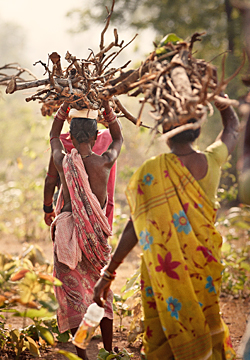
The plight of millions of people in rural India who are reliant on solid fuels to cook their food and to heat their homes is the focus of Fires, Fuel & the Fate of 3 Billion: The State of the Energy Impoverished by Gautam Yadama with photography by Mark Katzman. (The book is forthcoming from Oxford University Press.)
A two-year NIH grant will allow Professors Yadama, Pratim Biswas, Mario Castro and Kenneth Schechtman to place cleaner-burning, affordable cookstoves in poor households in such rural areas. The goal is to determine how clean cookstove technologies find sustained use in rural households and help reduce harmful emissions, and improve human health.
“We’re implementing a systematic randomized control study by selecting a model of a stove that has been deemed effective and clean,” Yadama explains. “Then we want to deploy it with the help of our partners: Professor Kalpana Balakrishnan, director of the WHO Collaborating Centre for Occupational Health and head of the Department of Environmental Health Engineering at Sri Ramachandra University, and the Foundation for Ecological Security, both in India.
“These are very important partners because they give us access to approximately 3,000 villages across seven states in India and some of the best scientists in India researching exposure to cookstoves emissions. We need such capacity for field implementation and scientific study to crack this poverty–energy nexus.”
Once the team has selected the exact stove they will use in the study and it has been distributed in the field, the researchers will look at its impact — whether the stove in fact reduces the harmful emissions and whether that brings improvements to human health over time.
“A key aspect is the sustainability of the technology in the real conditions of a household and a community,” Yadama says. “This is where we need NGO partnership, because they will monitor these households every two weeks to figure out if people are using [the stoves] the way they should be. Then we want to determine if it’s actually making a difference.”
The data generated will allow the team to understand the impact on emissions, health outcomes and sustainability.
Yadama says, “First is to prove that it works, and second is, if it does work, why are some people disusing it? That black box we have to unpack. We don’t know a lot about why people abandon something that seemingly works.”
His book calls for transdisciplinary thinking, he says. “We feel that this problem really requires a big effort on the part of universities in melding disciplines to understand the problem in the field, not just slices of it. Until and unless we traverse this entire spectrum, we will not fulfill the promise of technologies.”
For more information, visit http://publichealth.wustl.edu/people/Pages/RuralIndia.aspx.
Comments and respectful dialogue are encouraged, but content will be moderated. Please, no personal attacks, obscenity or profanity, selling of commercial products, or endorsements of political candidates or positions. We reserve the right to remove any inappropriate comments. We also cannot address individual medical concerns or provide medical advice in this forum.